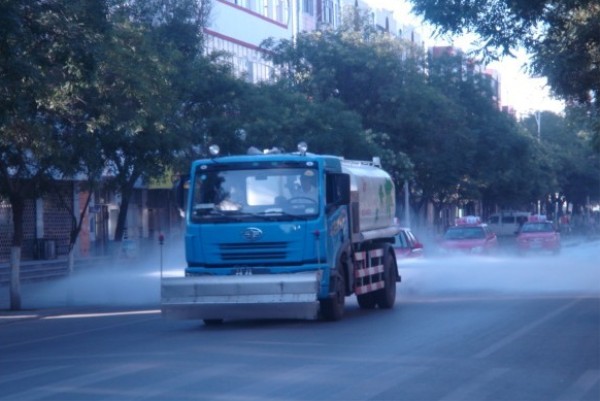Sprinklers can be seen during the summer to spray water on the road, not only to relieve the heat but also to make the road cleaner. What else does the sprinkler do? What else can a sprinkler do? Specifically, this professional car has the following uses. First of all, it can be used to clean the city roads. The main role of the sprinkler is to clean the road surface, especially in northern cities where there is a lot of dust and it has a great influence on the urban environment. For the cleaning of the road surface, not only the solid waste should be disposed of, but also the dust must be treated. Sprinkling water through a sprinkler can effectively suppress this dust and create a good environment for the city. Secondly, spraying water on the road with a sprinkler can relieve the dry weather during summer drought. In summer, the temperature is very high, and the surface temperature is higher than the temperature in the air. This has a certain influence on pedestrians and the urban environment. Watering the pavement can have the effect of lowering temperature and relieving drought. Sprinklers are more efficient in watering, and they are very significant in terms of cooling, which brings people a more appropriate urban environment. Once again, the sprinkler can also be used for greening the city. The sprinkler can also carry out urban greening work because it has a compartment that can hold the water source and can be used to irrigate trees and lawns only by connecting the pipes. For those inconvenient places for water intake, sprinkler trucks are required to complete these greening works, especially for large-scale sprinklers, and the amount of water transported can effectively irrigate trees. Finally, sprinklers can also be used to rescue people in special circumstances. Because the sprinkler has the function of storing water and transporting water, it can also be used to transport water in the event of a sudden fire. It also has certain significance for rescue and disaster relief. However, due to the lack of a power system, the sprinkler has a relatively small head for water, which is not conducive to high-level sprinkler operations and can only complete the task of transportation.
A hoist is a device used for lifting or lowering a load by means of a drum or lift-wheel around which rope or chain wraps. It may be manually operated, electrically or pneumatically driven and may use chain, fiber or wire rope as its lifting medium.
The basic hoist has two important characteristics to define it: Lifting medium and power type. The lifting medium is either wire rope, wrapped around a drum, or load-chain, raised by a pulley with a special profile to engage the chain. The power can be provided by different means. Common means are hydraulics, electrical and air driven motors. Both the wire rope hoist and chain hoist have been in common use since the 1800s, however mass production of an Electric Hoist did not start until the early 1900s and was first adapted by Germany. A hoist can be built as one integral-package unit, designed for cost-effective purchasing and moderate use, or it can be built as a built-up custom unit, designed for durability and performance. The built-up hoist will be much more expensive, but will also be easier to repair and more durable. Package units were once regarded as being designed for light to moderate usage, but since the 60s this has changed. Built-up units are designed for heavy to severe service, but over the years that market has decreased in size since the advent of the more durable packaged hoist. A machine shop or fabricating shop will use an integral-package hoist, while a Steel Mill or NASA would use a built-up unit to meet durability, performance, and repairability requirements. NASA has also seen a change in the use of package hoists. The NASA Astronaut training pool, for example, utilizes cranes with packaged hoists.
Hoist/Hoisting Mechanism,Hoisting Mechanisms,Hoist Mechanism,Hoist Motor Eurocrane (China) Co., Ltd. , https://www.craneparts.pl
October 05, 2019